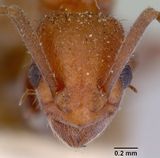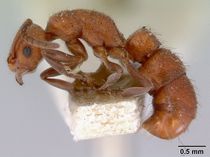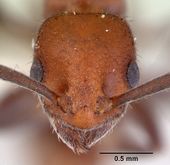Key to Australian Platythyrea Species
The following key to Australian Platythyrea species (based on workers and queens) has been modified from Brown (1975[1]).
1
- Petiolar node seen from directly above longer than broad, or rarely about as broad as, or even slightly broader than, long, but always much narrower than pronotum; maxillary palpi short, not extending much beyond buccal cavity => Platythyrea parallela
- Petiolar node seen from above much broader than long (W at least 1.25 X L), nearly, or quite, as broad as pronotum; maxillary palpi very long, extending almost to foramen magnum => 2
2
- Petiolar node brownish red, contrasting with dark brown of head and gaster (E, S, and SW Australia) => Platythyrea turneri
- Head and body unicolorous brown or ferruginous => 3
3
- Color dark brown; most standing hairs of dorsal body surfaces < 0.08 mm long; posterodorsal margin of petiolar node unarmed in the middle (SW Australia) => Platythyrea micans
- Color yellowish ferruginous; most standing hairs of dorsal body surfaces > 0.10 mm long; posterodorsal margin of petiolar node with a weakly developed to sharp, upturned median tooth (S Australia and SW Australia) => Platythyrea brunnipes
References
- ↑ Brown, W.L.,Jr. 1975. Contributions toward a reclassification of the Formicidae. 5. Ponerinae, tribes Platythyreini, Cerapachyini, Cylindromyrmecini, Acanthostichini, and Aenictogitini. Search Agriculture 5. Entomology (Ithaca) 15: 1-115.









